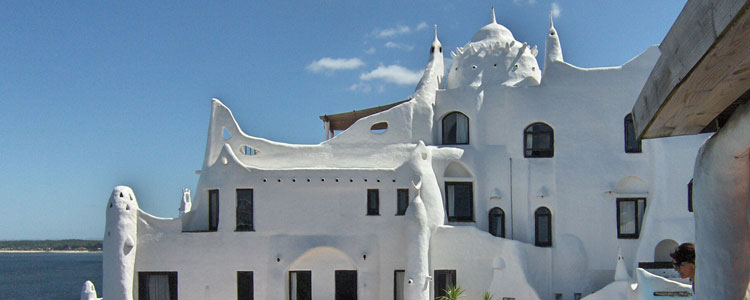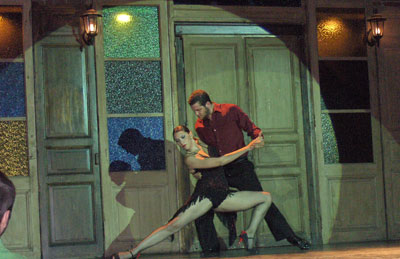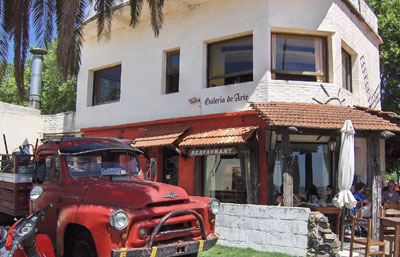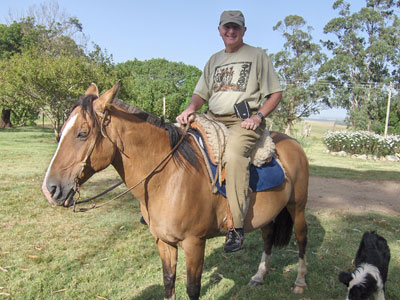Discovering pristine beaches, wonderful wines and a little adventure in Uruguay
by Thomas Johanneck, McLean, VA
Although South Americans and Europeans of Latin origin have known and traveled Uruguay for quite some time, in planning my trip I found useful Internet information in English to be elusive, and finding a US-based company with Uruguay-only offerings proved impossible.
Fortunately, I discovered that the “Rough Guide to South America on a Budget” had a useful chapter on Uruguay that discussed all the country’s highlights and contained more detailed and “vision friendly” maps than either Frommer’s or Fodor’s books on South America.
With basic information in hand on the places I wished to visit, I still needed to find a company that specialized in Uruguay. Finally, via the Internet, I discovered Vivir Uruguay, operated by twin sisters Adriana and Elina Braceras Lussich.
Making arrangements
Adriana and Elina were eager and more than happy to custom-craft my 11-day, January 2010 adventure hitting all of Uruguay’s major attractions, including the cities of Montevideo, Colonia del Sacramento and Punta del Este. Side excursions to the wine trails near Montevideo and an estancia (ranch) in Rocha plus visits to Bosque de Ombúes forest, Cabo Polonio, Punta del Diablo and Santa Teresa Fortress were also scheduled.
Adriana and Elina were very responsive via e-mail, and the majority of my questions were answered that way. However, they also used Skype, so we engaged in a free video teleconference over our computers. Being able to see and converse with my planners and exchange information in this way to fine-tune my requests substantially increased my confidence that they were legitimate travel professionals.
Once all arrangements were made, I received an e-mail containing an Excel spreadsheet of the agreed-to itinerary as well as receipts along the way for my initial and final payments.
The high-season, land-only adventure cost $3,605, and I was asked to use Western Union or my bank to wire the required two payments. I arranged my own round-trip air via the American Airlines website, flying from Washington, DC, through Miami to Montevideo for $1,644. There were some airfares that were cheaper by $200 or less, but those required an additional stop in another Central or South American country.
Breakfasts were included throughout, as were the lunches and dinners at the estancia and one of the side-trip lunches. I spent an additional $400 on assorted meals, snacks and a couple of souvenirs. I carried cash, but ATMs were conveniently located in all the major cities.
Getting oriented
Montevideo’s new Aeropuerto de Carrasco, which opened in late December ’09, is quite spacious and modern and I had no difficulties during arrival. (There were minor difficulties during my departure at the end of my trip, when American Airlines’ computer system went down for 30 minutes and new screening procedures delayed my departure by another 1½ hours. However, the airline realized that I would be hard-pressed to catch my connecting flight, so they changed my connection to the next later flight from Miami into DC.)
I was pleased to discover that Montevideo has miles and miles of beaches, and Pocitos Beach was just one block from my hotel.
I stayed at the Punta Trouville Suites (phone +5982 7120903), a perfectly adequate business hotel, where my room included a kitchenette with a refrigerator and a microwave. The hotel is made up of two buildings; a short half-block walk was required to get to the other building for breakfast. Each building had two computers providing complimentary Internet access. The bus line was two blocks away.
Since most people in Montevideo leave the city for their summer vacations in January, the beaches were not excessively crowded. This proved to be the case at the other beach towns as well. The hotels provided beach towels, and chairs and umbrellas could be rented on the beach for $10.
Uruguayans eat late lunches, and dinners start at 9 p.m. or later.
Museums open at 11 a.m. and close at 5 p.m. and have one day each week on which they’re closed for cleaning. If you have an interest in a particular museum, check to make sure it will be open on the day you plan to visit.
Special visits
I like to visit folkloric shows, so my itinerary included dinner and a dance performance one evening, which included tango, murga and candombe music. The tangos were performed with their usual elegance.
Murga is a form of popular musical theater performed in Montevideo primarily during Carnival. Candombe is drum-based and originated from the African population that settled in Montevideo. It is a style unique to Uruguay, and it, too, is performed during Carnival.
Uruguay has its own growing wine industry. Their red, somewhat like a merlot, is produced from the tannat grape and is ubiquitous in the country. Some fine whites are also available, particularly the Viognier. A nice half-day wine tour of two wineries can be arranged at Montevideo’s Mercado del Puerto tourist information kiosk for 1,200 pesos (US$61).
My itinerary included the half-day tour, visiting the H. Stagnari and De Lucca [website in Spanish only] wineries.
H. Stagnari is a large industrial winery similar in size to those found in California’s Napa Valley, with friendly staff and a delicious Viognier. De Lucca is a smaller operation, at which the owner, Reinaldo de Lucca, usually provides the tour and tasting. I found De Lucca’s flagship tannat wine to be the smoothest and most delicious of the many tannats I tried while in Uruguay.
Wine tastings were accompanied by assortments of cheeses, sausage, crackers and fruit. Wines were available for purchase by the bottle, and many were within a reasonable range of 100-200 pesos ($5-$10).
The Old City
The Mercado del Puerto (Port Market) in Montevideo’s Ciudad Vieja (Old City) is definitely worthy of a visit. Make sure you bring your appetite to enjoy a parrillada mixed-meat grill at one of the many delicious and reasonably priced restaurants there.
However, it is worth noting that the market is open only from 9 a.m. to 6 p.m. After that, the Port Market building is closed and locked and only three good but overpriced restaurants are available in the area.
The surrounding Ciudad Vieja area is “dead” — no open businesses and no pedestrian traffic — and dangerous after dark.
After completing my dinner at 9:30, I found myself walking through deserted streets. Two young hoodlums also noticed me, and only due to the ineptness of the one who tried to pickpocket me, coming up silently from behind and reaching into my left-front pocket, did I keep from losing anything. The tourist police, who are ever-present in Ciudad Vieja in the daytime, were nowhere to be seen.
My advice — do as the guidebooks recommend and stay out of Ciudad Vieja at night.
Colonia and Punta del Este
Colonia del Sacramento is a “must see,” with a photo opportunity or two around every corner and an assortment of antique vehicles which appear to have been on the same streets for 40 years or more. This waterside UNESCO World Heritage city has fine examples of colonial Portuguese and Spanish architecture on opposing streets.
I stayed at the boutique hotel Posada Don Antonio (Ituzaingó 232), which is located on the edge of the Old City area, a convenient short walk away from all of Colonia’s interesting sites.
Colonia has a series of seven small museums, but on the day I visited (Thursday) three were closed. Had I known this, I would have purchased my museum pass the previous day so that I could have visited all of the museums. The ticket (25 pesos, or $1.25) was good for multiple days, expiring for each particular museum when that museum stamped the ticket to note that it had been visited.
Punta del Este reminded me of a smaller, more provincial Miami, but to wealthy Argentines who flood in from Buenos Aires for their summer vacations it is called the Riviera of South America. It has miles and miles of pristine beaches, and even during high season I did not find them to be overly crowded.
Not noted in the guidebooks but included in my itinerary was a not-to-be-missed experience at Casapueblo, the house of Uruguayan artist Carlos Páez Vilaró. Located in Punta Ballena, this “living sculpture” includes a museum, an art gallery and Hotel Casapueblo. In creating its design, the artist prided himself on the lack of straight lines used. The museum and art gallery can be visited for a small fee (120 pesos), and there is a café with a wonderfully relaxing oceanside view.
Estancia experience
At my next stop, in ranch country near the town of Rocha, I stayed at the estancia El Charabon, which had charming hosts, Jorge Zuasnabar and his wife, Graciela Sbarbaro. A highlight of my estancia stay was herding cattle with the resident gaucho, Fernando, and his friendly border collies.
Bruno, a renowned chef who honed his skills at the Punta del Este restaurant Lo de Tere, prepared three-course gourmet meals which were breathtaking in their beautiful presentations and deliciously fun to consume. I was not anticipating such cuisine, so it was an unexpected pleasure.
El Charabon also has an attractive bar and wine cellar and stocks a relatively extensive selection of Uruguayan wines.
Great guide
With no electricity except to power its lighthouse, the town of Cabo Polonio is charming, and it should only be experienced by enlisting the services of “Condor” Raul Guidi (phone 098817400 or e-mail raulguidi@hotmail.com), one of Cabo Polonio’s 78 permanent residents. Raul, who knows every place and everyone in town, also has a duplex cottage along the beach that can be rented for 800-1,200 pesos ($40-$60) during high season; the rate is less during off-season.
Raul was the guide on my prepaid tours to the Bosque de Ombués forest, Punta del Diablo, the Santa Teresa Fortress (which has an interesting botanical garden), the Brazilian border town of Chuy, his hometown of Cabo Polonio and other attractions.
Raul has his own vehicle and will pick up travelers from surrounding areas, such as El Charabon. I believe his rate for a day trip (10 hours) is approximately $150.
Arranging a visit
Uruguay is still enough off the beaten path that the services of trusted travel agents, such as I discovered in Elina and Adriana of Vivir Uruguay, are worth their weight in gold. After traveling to nearly 80 countries, I can attest to the personal and caring service and attention to detail offered by this sister team, and I heartily recommend them to anyone planning an adventure in Uruguay.
The Vivir Uruguay website has some great suggestions for how to visit Uruguay, and the sisters will gladly offer suggestions and customize an itinerary to the individual traveler’s time frame and interests.
I also recommend the other facilities and services mentioned in this article and would be happy to converse with anyone contemplating a trip to Uruguay (e-mail c/o ITN).




